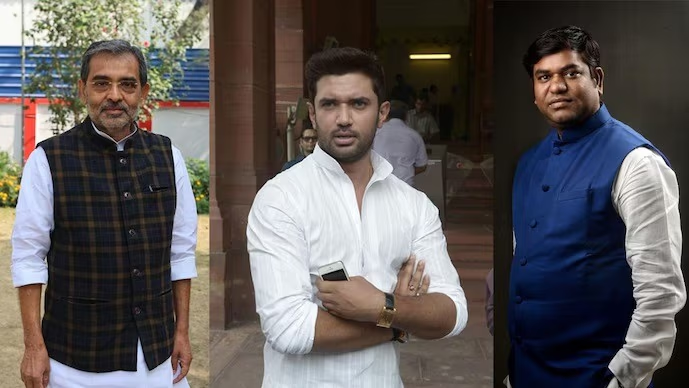As the Bihar Assembly elections approach, both the ruling National Democratic Alliance (NDA) and the opposition Grand Alliance are busy strengthening ties among their component parties. NDA leaders are holding press conferences and coordination meetings to demonstrate unity. Similarly, under Tejashwi Yadav's leadership, the opposition has also formed a Coordination Committee. Both alliances claim to be united as they prepare for the electoral battlefield, turning the spotlight on smaller parties which gain political significance in such scenarios. Our Bihar series today focuses on these small yet significant parties.
Lok Janshakti Party (Ram Vilas)
Following the rebellion by uncle Pashupati Paras, Chirag Paswan established his party, Lok Janshakti Party (Ram Vilas). Chirag's party is part of the ruling NDA, and he himself holds a ministerial position in the central government from his party's quota. The LJP (R) relies on the Dalit and Paswan vote bank, comprising 5.31% of Bihar's population, as per the state's caste census.
While these numbers may not independently ensure an outright win, allied support can enhance victory odds, as seen in past elections when Chirag diverged from NDA to contest JDU's seats, which led to JDU slipping to third place. Nitish Kumar blamed Chirag’s party for splitting the votes.
Rashtriya Lok Janshakti Party
The Rashtriya Lok Janshakti Party (RLJP) is led by Chirag Paswan’s uncle Pashupati Paras. After the passing of Ram Vilas Paswan, Pashupati removed Chirag from the party's leadership, staking his claim on its name and symbol, offering support to the NDA government at the center. Pashupati served as a central minister, though the election commission froze the party's name and symbol.
Pashupati formed the RLJP, also targeting the Paswan vote bank. Although Chirag’s party joined NDA before the Lok Sabha elections, Pashupati found himself sidelined, with no seats offered to RLJP in the last Lok Sabha elections. He wasn’t even able to secure a seat for himself. Now, Pashupati has severed ties with NDA, fueling speculation of aligning his party with the Grand Alliance, potentially as RJD's strategy to appeal to Dalit voters.
Hindustani Awam Morcha (Democratic)
Led by central minister Jitan Ram Manjhi, the Hindustani Awam Morcha (Democratic) is an NDA component. Nitish Kumar's Janata Dal United led the NDA in Bihar. Jitan Ram Manjhi, former Chief Minister of Bihar, is from the Musahar caste, classified under the Mahadalit category. Manjhi’s party focuses on claiming the Mahadalit vote bank, representing about 14% of the state's population, with his Musahar caste at 3.09%. Jitan Ram Manjhi himself holds a ministerial post in the central government, while his son Santosh Suman serves as a minister in Nitish Kumar’s Bihar government.
Rashtriya Loktantrik Morcha
Headed by central minister Upendra Kushwaha, the Rashtriya Loktantrik Morcha (RLM) is also part of the ruling NDA. Upendra Kushwaha hails from the Koiri caste, a significant pillar in Nitish Kumar's Luv-Kush (Kushwaha-Kurmi) equation, comprising 4.21% of Bihar's population. Despite being a party with zero legislators, RLM's importance is evident as Upendra Kushwaha, after losing in the Lok Sabha elections, was brought to Parliament via Rajya Sabha, and made a central minister by the NDA government.
Vikassheel Insaan Party
Mukesh Sahni's Vikassheel Insaan Party (VIP) allied with NDA in the previous Bihar elections, winning four seats, yet its MLAs later joined BJP. Mukesh Sahni is now part of the opposition’s Grand Alliance, and staked his claim for the Deputy CM's post in the case of forming a government. Roughly 2.61% of Bihar’s population belongs to the Sahni (Mallah) community.
VIP stakes claims on Nishad votes. Including other sub-castes with Mallah, the caste survey indicates the total Nishad population is approximately 9.65%, with specific sub-populations like Amat at 0.21%, Kevat at 0.71%, and others contributing varying small percentages.
Viewing these small parties’ vote shares, they range from two to six percent, which on the canvas of numbers may seem minor. However, this voter base, when affiliated with a bigger party, could enhance victory prospects. In closely contested seats, these small voter-based parties can play a decisive role in determining win or loss.




